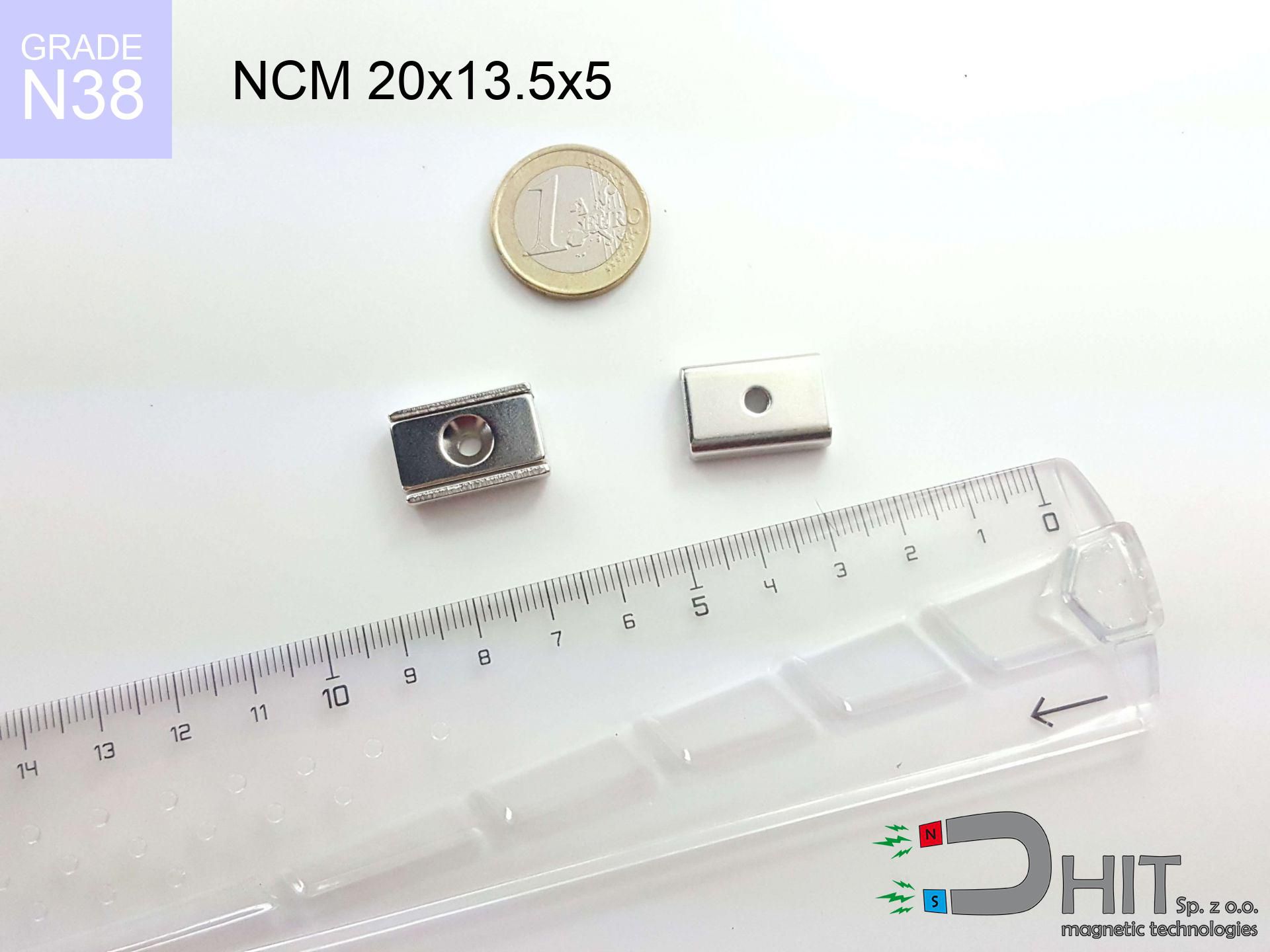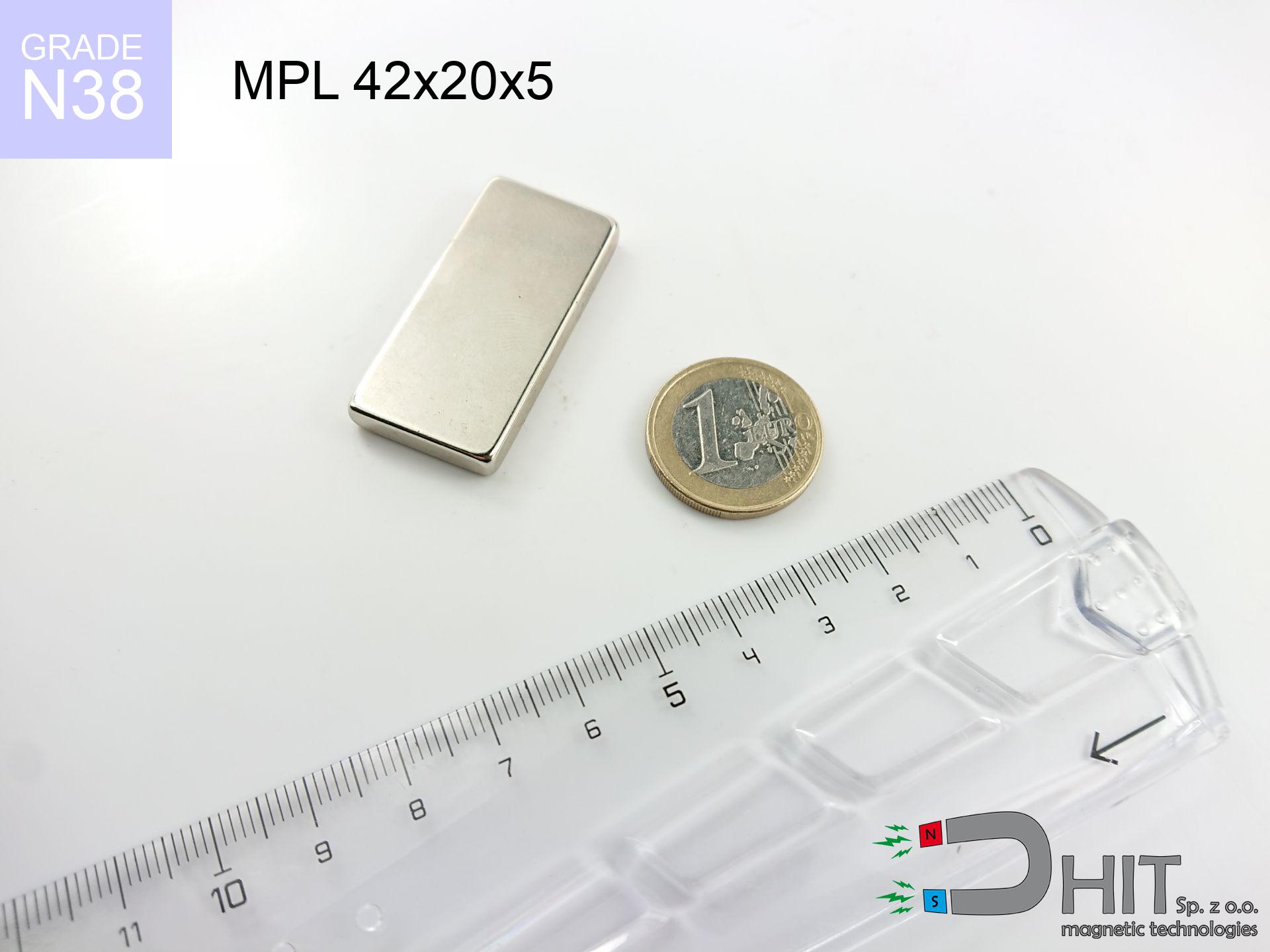NCM 20x13.5x5 / N38
channel magnetic holder
catalog number 360487
GTIN: 5906301814863
magnetizing direction
↑ axial
capacity ~
8.00 kg / 78.45 N
max. temperature
≤ 80
°C
catalog number 360487
GTIN: 5906301814863
magnetizing direction
↑ axial
capacity ~
8.00 kg / 78.45 N
max. temperature
≤ 80 °C
7.29 ZŁ gross price (including VAT) / pcs +
5.93 ZŁ net price + 23% VAT / pcs
bulk discounts:
need more quantity?Want to talk about magnets?
Call us tel: +48 22 499 98 98 or write through form on our website. You can check the mass and the appearance of neodymium magnets in our force calculator force calculator
Orders placed by 2:00 PM will be shipped on the same business day.
Specification: channel magnetic holder 20x13.5x5 / N38 ↑ axial
Magnetic properties of the material N38
Physical properties of sintered neodymium magnets Nd2Fe14B
Choose recommended products
Advantages as well as disadvantages of neodymium magnets NdFeB.
In addition to immense power, neodymium magnets have the following advantages:
- They do not lose strength over time - after approximately 10 years, their strength decreases by only ~1% (theoretically),
- They protect against demagnetization caused by external magnetic field extremely well,
- In other words, thanks to the glossy nickel, gold, or silver finish, the element gains an visually attractive appearance,
- They have exceptionally high magnetic induction on the surface of the magnet,
- By using an appropriate combination of materials, they can achieve high thermal resistance, allowing them to operate at temperatures up to 230°C and above...
- Due to the option of accurate forming and adaptation to individual needs – neodymium magnets can be produced in a wide range of shapes and sizes, which enhances their versatility in applications.
- Key role in advanced technologically fields – are used in hard drives, electric motors, medical equipment and very highly developed apparatuses.
Disadvantages of neodymium magnets:
- They are prone to breaking as they are extremely fragile when subjected to a strong impact. If the magnets are exposed to impacts, it is suggested using magnets in a protective case. The steel housing in the form of a holder protects the magnet from impacts and also increases its overall strength,
- Magnets lose their power due to exposure to high temperatures. In most cases, when the temperature exceeds 80°C, these magnets experience permanent reduction in strength (although it is worth noting that this is dependent on the form and size of the magnet). To avoid this problem, we offer special magnets marked with the [AH] symbol, which exhibit high temperature resistance. They can operate even at temperatures as high as 230°C or more,
- Magnets exposed to a humid environment can corrode. Therefore, when using them outdoors, we recommend using waterproof magnets made of rubber, plastic, or other moisture-resistant materials,
- The use of a cover - a magnetic holder is recommended due to the limited production capabilities of creating threads or complex shapes in the magnet
- Health risk arising from small pieces of magnets can be dangerous, in case of ingestion, which is crucial in the aspect of protecting young children. It's also worth noting that small elements of these devices can hinder the diagnostic process when they are in the body.
Exercise Caution with Neodymium Magnets
Neodymium magnets can demagnetize at high temperatures.
Even though magnets have been observed to maintain their efficacy up to temperatures of 80°C or 175°F, it's essential to consider that this threshold may fluctuate depending on the magnet's type, configuration, and intended usage.
Neodymium magnets are the strongest magnets ever invented. Their strength can shock you.
Familiarize yourself with our information to correctly handle these magnets and avoid significant injuries to your body and prevent disruption to the magnets.
Neodymium magnets should not be around youngest children.
Remember that neodymium magnets are not toys. Be cautious and make sure no child plays with them. Small magnets can pose a serious choking hazard. If multiple magnets are swallowed, they can attract to each other through the intestinal walls, causing significant injuries, and even death.
Keep neodymium magnets away from GPS and smartphones.
Magnetic fields generated by neodymium magnets interfere with compasses and magnetometers used in navigation, as well as internal compasses of smartphones and GPS devices.
Magnets made of neodymium are incredibly delicate, they easily crack as well as can crumble.
Neodymium magnets are characterized by considerable fragility. Magnets made of neodymium are made of metal and coated with a shiny nickel, but they are not as durable as steel. At the moment of connection between the magnets, small metal fragments can be dispersed in different directions.
Keep neodymium magnets away from TV, wallet, and computer HDD.
The strong magnetic field generated by neodymium magnets can damage magnetic media such as floppy disks, video tapes, HDDs, credit cards, magnetic ID cards, cassette tapes, etc. devices. They can also destroy videos, televisions, CRT computer monitors. Do not forget to keep neodymium magnets at a safe distance from these electronic devices.
Neodymium magnets are primarily characterized by their significant internal force. They attract to each other, and any object that comes in their way will be affected.
In the situation of placing a finger in the path of a neodymium magnet, in such a case, a cut or even a fracture may occur.
The magnet coating contains nickel, so be cautious if you have a nickel allergy.
Studies clearly indicate a small percentage of people who suffer from metal allergies such as nickel. An allergic reaction often manifests as skin redness and rash. If you have a nickel allergy, try wearing gloves or avoid direct contact with nickel-plated neodymium magnets.
Keep neodymium magnets away from people with pacemakers.
In the case of neodymium magnets, there is a strong magnetic field. As a result, it interferes with the operation of a heart pacemaker. However, if the magnetic field does not affect the device, it can damage its components or deactivate the device when it is in a magnetic field.
Dust and powder from neodymium magnets are highly flammable.
Do not attempt to drill into neodymium magnets. Mechanical processing is also not recommended. Once crushed into fine powder or dust, this material becomes highly flammable.
Please see the article - What danger lies in neodymium magnets? You will learn how to handle them properly.



![magnetic separator 25x200 [2xM8] / N42 magnetic separator 25x200 [2xM8] / N42](https://cdn3.dhit.pl/graphics/products/sm-25x200-2xm8-dos.jpg)

![magnetic holder internal thread 75x33x18 [M10] GW / N38 magnetic holder internal thread 75x33x18 [M10] GW / N38](https://cdn3.dhit.pl/graphics/products/umgw-75x33x18-m10-gw-cak.jpg)

